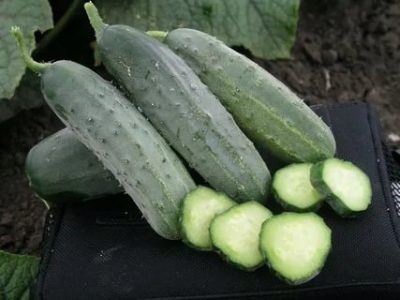
- Authors: NUNHEMS B.V.
- Year of approval: 2002
- Growth type: determinant
- Fruit weight, g: 95-100
- Fruit length, cm: 10-12 cm
- Fruit color: green
- Cucumber Mosaic Virus Resistance: stable
- Ripening terms: early
- Pollination: bee-pollinated
- Fruit shape: cylindrical
Cucumber Hector is a hybrid of Dutch selection, which has recently become widespread among Russian gardeners, especially among those who spend the summer in their summer cottages and have small plots of land for their vigorous activity. Although it is said that the main reason for the demand for the variety is its taste, it has other features that put it on the list of priorities for growing.
Breeding history
Cucumber Hector is a variety bred by a team of breeders from Holland, which worked harmoniously at the beginning of this century. Their main goal is to obtain cucumbers with certain properties: ultra-early ripening, with stable immunity, excellent taste, high yield, marketable and presentable appearance. Judging by the widespread prevalence and demand in the European and Russian territories, their work on the new variety was crowned with success.
The only drawback of Hector is considered the need for the annual purchase of seed material (as with every hybrid, the seeds of which cannot be obtained at home). However, even the expensive cost does not stop farmers from the intention to breed Hector annually to obtain excellent quality zelents.
Description of the variety
Several points deserve special attention and become indisputable arguments in favor of choosing the Hector cucumber. It:
determinant species, with compact size, not growing and not reaching a height of more than a meter;
ultra-early ripe cucumber, the fruits of which can be obtained within 40-45 days after germination;
friendly fruiting continues for 3 months;
calibrated greens are ideal in size - they reach 10-12 cm in length, up to 3 cm in diameter, and weigh about 100 g;
universal use of fruits and high yield (up to 16 kg on a trellis, if grown in a greenhouse, in open ground - about 6 kg).
As the main argument, the unique qualities are cited, highly appreciated by summer residents and buyers, who prefer Hector to many varieties with a proven long-term reputation.
Characteristics of the appearance of plants and zelents
Cucumber Hector is a determinant variety that can be easily distinguished by compact bushes 80-100 cm high, small dark green beautifully carved leaves and a strong stem, as well as by the number of ovaries that it is literally showered after flowering. The leaves practically do not turn yellow, the lateral processes are undeveloped, this ensures the rapid formation and development of zelents.
Small fruits appear and ripen together. The maximum weight of each cucumber is 100 g. The tuberosity is small, the skin is covered with light thorns and hides dense flesh, without voids and practically without seeds. Cucumbers of this variety are characterized by the ability to tolerate transportation and storage well, they are ribbed and covered with a weak waxy bloom.
Purpose and taste of fruits
Cucumbers can be grown in the greenhouse and outdoors, this does not change their excellent taste. Users and buyers describe the taste as traditionally sweetish, the aroma is pronounced and pleasant, the aftertaste is persistent. This variety is grown for:
commercial purposes (due to long-term fruiting and high yields);
fresh consumption (appetizers, mono- and combined salads);
canning (pickling, pickling, lightly salted and assorted vegetable canned food).
Of the shortcomings, only the skin is noted, which tends to thicken during long-term storage, or if the fruits are not removed from the bush in time. Indeed, there are so many of them that you might not notice in the leaves, especially when planted in a greenhouse. The hardened skin is believed to have a negative impact on palatability when canning.
Maturation
It starts simultaneously in several nodes at once and lasts more than 3 months. From the moment the sprouts appear until this long-awaited event, about 40 days pass (the period may be slightly postponed in cold regions, but not dramatically). The flowers are female, there are practically no barren flowers, a full-fledged and attractive green plant appears in the place of each.
Yield
It can compete with the most famous varieties. With minimal maintenance - 3.5-6 kg per 1 sq. m. In greenhouse conditions - up to 16 kg. Correct care and proper farming techniques increase the likelihood of a good harvest. This is evidenced by the reviews of gardeners.
Growing and care
The hybrid's colored seeds in a bag means they don't need to be pretreated before planting. If they are not coated, they are prepared according to the usual scenario. The preparation of seedlings for open ground can be done in late April - early May. Good soil, permanent watering and fertilization at the right time will allow you to get the expected result - an abundance of strong, beautiful and small-sized cucumbers with excellent taste.

In order to collect strong, tasty and beautiful cucumbers on your site, you need to make top dressing. Lack of nutrients can negatively affect the appearance of the plant and significantly reduce the yield. Fertilize cucumbers with organic fertilizers in combination with mineral fertilizers. With the right balance of these components and adherence to the fertilizing schedule, the cucumber yield will be maximum.

Despite their popularity, cucumbers are often attacked by diseases and pests. From them, cucumber plantings often die before the start of fruiting. In order to prevent this from happening, it is necessary to try to prevent ailments or get rid of them at the very beginning, having studied in detail their causes of occurrence, signs and methods of treatment.





























































































